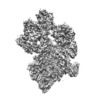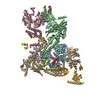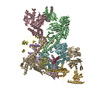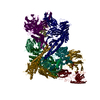+ Open data
Open data
- Basic information
Basic information
| Entry | Database: EMDB / ID: EMD-21259 | |||||||||
|---|---|---|---|---|---|---|---|---|---|---|
| Title | Cryo-EM structure of the BBSome-ARL6 complex | |||||||||
 Map data Map data | BBSome-ARL6 complex | |||||||||
 Sample Sample |
| |||||||||
 Keywords Keywords | Cilia / Bardet-Biedl Syndrome / PROTEIN TRANSPORT | |||||||||
| Function / homology |  Function and homology information Function and homology informationBBSome binding / establishment of anatomical structure orientation / BBSome-mediated cargo-targeting to cilium / protein transport from ciliary membrane to plasma membrane / receptor localization to non-motile cilium / multi-ciliated epithelial cell differentiation / BBSome / protein localization to non-motile cilium / renal tubule development / camera-type eye photoreceptor cell differentiation ...BBSome binding / establishment of anatomical structure orientation / BBSome-mediated cargo-targeting to cilium / protein transport from ciliary membrane to plasma membrane / receptor localization to non-motile cilium / multi-ciliated epithelial cell differentiation / BBSome / protein localization to non-motile cilium / renal tubule development / camera-type eye photoreceptor cell differentiation / smoothened binding / establishment of planar polarity / photoreceptor connecting cilium / inner ear receptor cell stereocilium organization / axonemal microtubule / retina layer formation / patched binding / membrane coat / olfactory bulb development / establishment of epithelial cell apical/basal polarity / protein localization to cilium / phosphatidylinositol-3-phosphate binding / regulation of stress fiber assembly / non-motile cilium assembly / regulation of smoothened signaling pathway / non-motile cilium / centrosome cycle / protein targeting to membrane / eating behavior / motile cilium / erythrocyte homeostasis / ciliary membrane / fat cell differentiation / pericentriolar material / B cell homeostasis / axoneme / protein polymerization / cilium assembly / intracellular transport / vesicle-mediated transport / axon guidance / protein localization to plasma membrane / intracellular protein transport / brain development / phospholipid binding / centriolar satellite / multicellular organism growth / Wnt signaling pathway / fibrillar center / sensory perception of smell / intracellular protein localization / protein transport / regulation of protein localization / protein-macromolecule adaptor activity / gene expression / RNA polymerase II-specific DNA-binding transcription factor binding / neuron projection / cilium / ciliary basal body / GTPase activity / centrosome / GTP binding / nucleoplasm / membrane / cytoplasm / cytosol Similarity search - Function | |||||||||
| Biological species |  | |||||||||
| Method | single particle reconstruction / cryo EM / Resolution: 4.0 Å | |||||||||
 Authors Authors | Yang S / Walz T | |||||||||
| Funding support |  United States, 1 items United States, 1 items
| |||||||||
 Citation Citation |  Journal: Elife / Year: 2020 Journal: Elife / Year: 2020Title: Near-atomic structures of the BBSome reveal the basis for BBSome activation and binding to GPCR cargoes. Authors: Shuang Yang / Kriti Bahl / Hui-Ting Chou / Jonathan Woodsmith / Ulrich Stelzl / Thomas Walz / Maxence V Nachury /   Abstract: Dynamic trafficking of G protein-coupled receptors (GPCRs) out of cilia is mediated by the BBSome. In concert with its membrane recruitment factor, the small GTPase ARL6/BBS3, the BBSome ferries ...Dynamic trafficking of G protein-coupled receptors (GPCRs) out of cilia is mediated by the BBSome. In concert with its membrane recruitment factor, the small GTPase ARL6/BBS3, the BBSome ferries GPCRs across the transition zone, a diffusion barrier at the base of cilia. Here, we present the near-atomic structures of the BBSome by itself and in complex with ARL6, and we describe the changes in BBSome conformation induced by ARL6 binding. Modeling the interactions of the BBSome with membranes and the GPCR Smoothened (SMO) reveals that SMO, and likely also other GPCR cargoes, must release their amphipathic helix 8 from the membrane to be recognized by the BBSome. | |||||||||
| History |
|
- Structure visualization
Structure visualization
| Movie |
 Movie viewer Movie viewer |
|---|---|
| Structure viewer | EM map:  SurfView SurfView Molmil Molmil Jmol/JSmol Jmol/JSmol |
| Supplemental images |
- Downloads & links
Downloads & links
-EMDB archive
| Map data |  emd_21259.map.gz emd_21259.map.gz | 152.5 MB |  EMDB map data format EMDB map data format | |
|---|---|---|---|---|
| Header (meta data) |  emd-21259-v30.xml emd-21259-v30.xml emd-21259.xml emd-21259.xml | 22.6 KB 22.6 KB | Display Display |  EMDB header EMDB header |
| Images |  emd_21259.png emd_21259.png | 52.3 KB | ||
| Filedesc metadata |  emd-21259.cif.gz emd-21259.cif.gz | 8.6 KB | ||
| Archive directory |  http://ftp.pdbj.org/pub/emdb/structures/EMD-21259 http://ftp.pdbj.org/pub/emdb/structures/EMD-21259 ftp://ftp.pdbj.org/pub/emdb/structures/EMD-21259 ftp://ftp.pdbj.org/pub/emdb/structures/EMD-21259 | HTTPS FTP |
-Validation report
| Summary document |  emd_21259_validation.pdf.gz emd_21259_validation.pdf.gz | 570.4 KB | Display |  EMDB validaton report EMDB validaton report |
|---|---|---|---|---|
| Full document |  emd_21259_full_validation.pdf.gz emd_21259_full_validation.pdf.gz | 570 KB | Display | |
| Data in XML |  emd_21259_validation.xml.gz emd_21259_validation.xml.gz | 6.5 KB | Display | |
| Data in CIF |  emd_21259_validation.cif.gz emd_21259_validation.cif.gz | 7.4 KB | Display | |
| Arichive directory |  https://ftp.pdbj.org/pub/emdb/validation_reports/EMD-21259 https://ftp.pdbj.org/pub/emdb/validation_reports/EMD-21259 ftp://ftp.pdbj.org/pub/emdb/validation_reports/EMD-21259 ftp://ftp.pdbj.org/pub/emdb/validation_reports/EMD-21259 | HTTPS FTP |
-Related structure data
| Related structure data |  6voaMC  6vnwC M: atomic model generated by this map C: citing same article ( |
|---|---|
| Similar structure data |
- Links
Links
| EMDB pages |  EMDB (EBI/PDBe) / EMDB (EBI/PDBe) /  EMDataResource EMDataResource |
|---|---|
| Related items in Molecule of the Month |
- Map
Map
| File |  Download / File: emd_21259.map.gz / Format: CCP4 / Size: 163.6 MB / Type: IMAGE STORED AS FLOATING POINT NUMBER (4 BYTES) Download / File: emd_21259.map.gz / Format: CCP4 / Size: 163.6 MB / Type: IMAGE STORED AS FLOATING POINT NUMBER (4 BYTES) | ||||||||||||||||||||||||||||||||||||||||||||||||||||||||||||
|---|---|---|---|---|---|---|---|---|---|---|---|---|---|---|---|---|---|---|---|---|---|---|---|---|---|---|---|---|---|---|---|---|---|---|---|---|---|---|---|---|---|---|---|---|---|---|---|---|---|---|---|---|---|---|---|---|---|---|---|---|---|
| Annotation | BBSome-ARL6 complex | ||||||||||||||||||||||||||||||||||||||||||||||||||||||||||||
| Projections & slices | Image control
Images are generated by Spider. | ||||||||||||||||||||||||||||||||||||||||||||||||||||||||||||
| Voxel size | X=Y=Z: 1.08 Å | ||||||||||||||||||||||||||||||||||||||||||||||||||||||||||||
| Density |
| ||||||||||||||||||||||||||||||||||||||||||||||||||||||||||||
| Symmetry | Space group: 1 | ||||||||||||||||||||||||||||||||||||||||||||||||||||||||||||
| Details | EMDB XML:
CCP4 map header:
| ||||||||||||||||||||||||||||||||||||||||||||||||||||||||||||
-Supplemental data
- Sample components
Sample components
+Entire : BBSome complex with ARL6 bound
+Supramolecule #1: BBSome complex with ARL6 bound
+Supramolecule #2: Bardet-Biedl syndrome 18 protein, BBS18, Bardet-Biedl syndrome 2 ...
+Supramolecule #3: ADP-ribosylation factor-like protein 6
+Macromolecule #1: Bardet-Biedl syndrome 18 protein
+Macromolecule #2: Bardet-Biedl syndrome 2 protein homolog
+Macromolecule #3: Bardet-Biedl syndrome 4 protein homolog
+Macromolecule #4: Bardet-Biedl syndrome 5 protein homolog
+Macromolecule #5: Bardet-Biedl syndrome 7 protein homolog
+Macromolecule #6: Tetratricopeptide repeat domain 8
+Macromolecule #7: Bardet-Biedl syndrome 9
+Macromolecule #8: ADP-ribosylation factor-like protein 6
+Macromolecule #9: BBS1 domain-containing protein
-Experimental details
-Structure determination
| Method | cryo EM |
|---|---|
 Processing Processing | single particle reconstruction |
| Aggregation state | particle |
- Sample preparation
Sample preparation
| Buffer | pH: 7.5 |
|---|---|
| Vitrification | Cryogen name: ETHANE / Chamber humidity: 100 % / Chamber temperature: 277 K / Instrument: FEI VITROBOT MARK IV |
- Electron microscopy
Electron microscopy
| Microscope | FEI TITAN KRIOS |
|---|---|
| Image recording | #0 - Image recording ID: 1 / #0 - Film or detector model: GATAN K2 SUMMIT (4k x 4k) / #0 - Average electron dose: 75.2 e/Å2 / #1 - Image recording ID: 2 / #1 - Film or detector model: GATAN K3 BIOQUANTUM (6k x 4k) / #1 - Average electron dose: 51.44 e/Å2 |
| Electron beam | Acceleration voltage: 300 kV / Electron source:  FIELD EMISSION GUN FIELD EMISSION GUN |
| Electron optics | Illumination mode: FLOOD BEAM / Imaging mode: BRIGHT FIELD |
| Experimental equipment |  Model: Titan Krios / Image courtesy: FEI Company |
 Movie
Movie Controller
Controller
















 Z (Sec.)
Z (Sec.) Y (Row.)
Y (Row.) X (Col.)
X (Col.)























